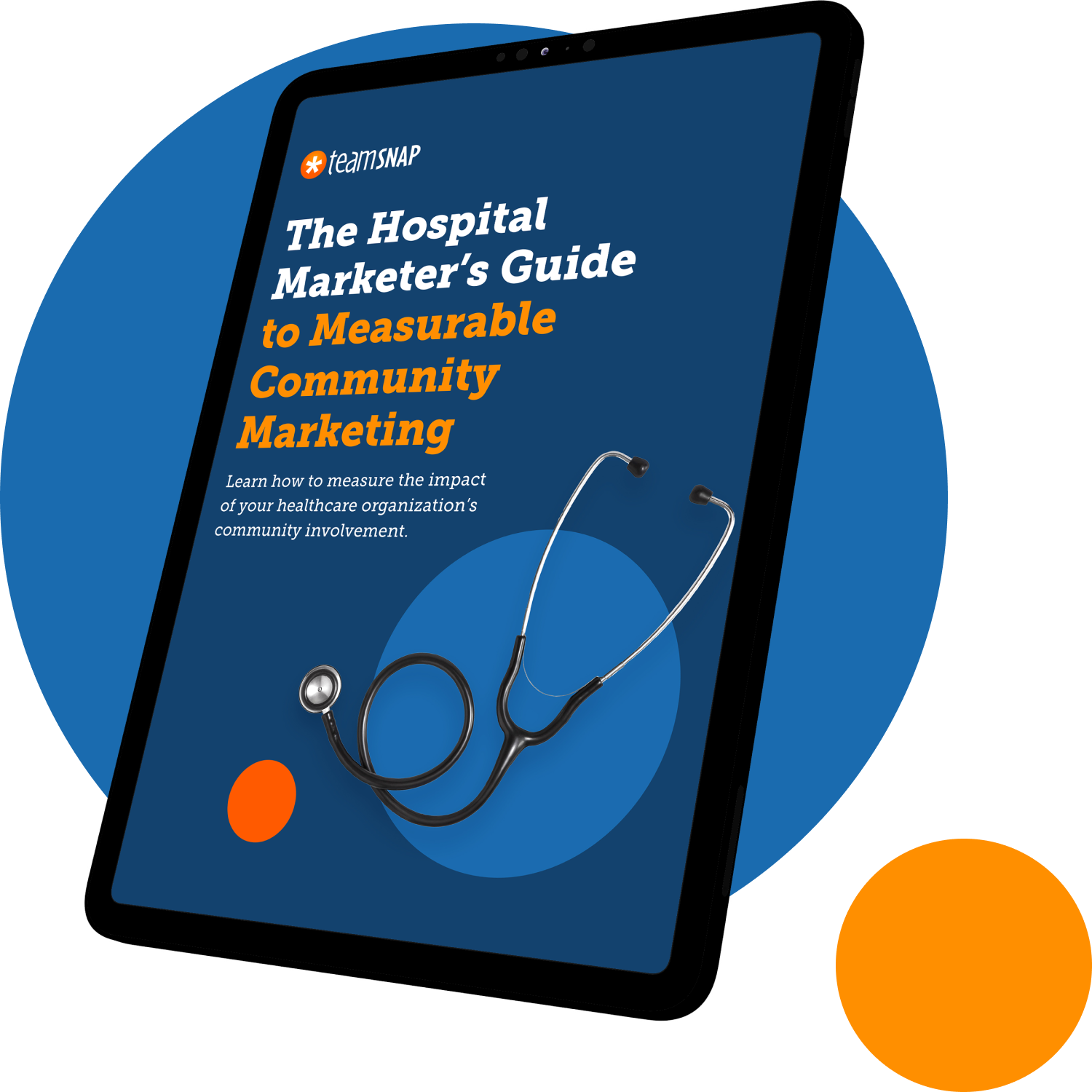Hospital Marketing With Local Sponsorships
Learn how to connect your healthcare organization with families in the community with measurable local marketing.
Download The Hospital Marketer's Guide

Hospital Marketing with Youth Sports Sponsorships
TeamSnap empowers brands to create authentic relationships with families through youth sports sponsorships and digital media targeting families in the #1 youth sports coordination app. Unlike other marketing channels, we engage families when and where it matters most - at the field, at home, and on the go.
Learn how our partners including Dairy Queen, Gatorade, Johnsonville, Marriott, and Panda Express use TeamSnap to reach the Chief Household Officer.
Learn MoreHOSPITAL MARKETING
Hospital marketing is the use of strategies and tactics, including advertising, promotions, branding, and communications, that are designed to improve the health of various populations throughout a community.
With strategies involving medical practice marketing, professionals must focus on delivering health information that is sensitive to the needs and concerns of prospective and current patients while ensuring that the communication is highly reliable and based on science.
Hospital marketing also is central to the overall success and growth of providers, whether they’re located in major metropolitan areas or rural communities. While this type of healthcare marketing is essential to sustainable growth for the provider, it also is critical in conveying important information throughout the community to support the well-being of each individual.
THE ORIGIN AND EVOLUTION OF MARKETING IN HEALTHCARE
Healthcare marketing and hospital marketing are relatively new when compared to marketing in other industries. It only was during the 1980s that many hospitals and medical providers started embracing marketing to communicate with current and prospective patients. While public relations was widely accepted before that time, many health professionals, especially those with a nonprofit model, considered hospital advertising an unethical practice.
However, by the late 1990s and early 2000s, healthcare marketing was becoming normalized. Some universities offered healthcare marketing as a specialized curriculum. Meanwhile, a majority of hospitals and healthcare providers established marketing departments.
Today, hospital marketing has significantly evolved. It is now multidisciplinary, with hospital marketers using traditional forms of public relations, marketing, advertising, and digital channels, such as social media, for patient outreach.
HOW IS HEALTHCARE MARKETING DIFFERENT FROM MARKETING IN OTHER INDUSTRIES
With so many major governmental regulations related to privacy in the healthcare industry, including HIPPA (https://www.hhs.gov/hipaa/index.html) (the Health Insurance Portability and Accountability Act), healthcare marketing is significantly different from marketing for other industries.
Also, medical providers must abide by regulations about how to advertise medical treatments and procedures. As a result, many hospitals and medical providers establish legal departments or hire legal consultants to review healthcare marketing campaigns to ensure that they don’t encounter challenges with truth-in-advertising laws and regulations.
Another challenge facing healthcare marketers, especially those who focus on hospital marketing, is the need to address a wide range of audiences and demographics. Unlike most marketing sectors, which have niche demographics that make it easier to narrow their campaigns to specific values, desires, and needs, hospital marketers generally must tailor marketing for parents of young children, young adults, the elderly, and middle-aged adults.
WHAT IS HOSPITAL MARKETING
While hospital marketing continues to evolve, at its core it can be defined as a process that includes a comprehensive mix of planned communication that engages current and future patients through awareness campaigns, relationship-building initiatives, and personalized advertising about the provider and specific health issues.
Strategic healthcare marketing should seek to understand the individual needs of each audience segment, and why they would choose to go to a specific provider for their healthcare needs. Healthcare marketers also should seek to engage patients throughout all phases of their connection with the hospital system. And, as stated by the Centers for Disease Control (CDC) (https://www.cdc.gov/pcd/issues/2006/jul/05_0238.htm), it should focus on providing health information and interventions that use customer-centered and science-based strategies to protect and promote the health of diverse populations.
While hospital marketing has emerged as one of the most comprehensive and competitive segments in the marketing industry, it is considered relatively new, especially when compared to for-profit marketing industry segments.
HOW HAS HEALTHCARE MARKETING CHANGED SINCE THE 1970S
Since the 1970s, healthcare marketing has evolved significantly. During that time, many professionals considered it unethical to “sell” a nonprofit hospital to potential patients.
While it wasn’t uncommon at that time for medical professional organizations to use marketing tactics to increase awareness about different health conditions, wellness, and the medical options available to them, most hospitals only focused on public relations as a form of outreach. They may have invested resources in health fairs and other community events.
It wasn’t until the 1980s that healthcare marketing started to emerge. The role of the marketing department in hospitals is now considered critical. Many attribute this change to the writings of Philip Kotler (https://en.wikipedia.org/wiki/Philip_Kotler), the author of Marketing for Non-Profit Organizations, and Scott MacStravic (https://www.amazon.com/Books-Scott-MacStravic/s?rh=n%3A283155%2Cp_27%3AScott+MacStravic), the author of Marketing Health Care. These experts helped legitimize healthcare marketing.
In the years that followed, more and more nonprofit healthcare organizations embraced marketing. Hospitals created marketing departments and hired various employees under numerous healthcare marketing job titles, including director of healthcare marketing, medical marketing manager, hospital marketing analyst, and healthcare marketing associate.
The healthcare marketing field has continued to evolve, with the digital marketing strategy for hospitals being embraced across the board. The healthcare marketing department serves as a critical partner in helping hospitals and other medical providers improve the health of people throughout their communities.
The hospital marketing industry also has evolved to meet the growing demands of patients, who want a deeper understanding of their medical concerns. Patients, as advocates of their health, often research hospital websites to seek answers that will help them make decisions on behalf of themselves and their families.
The changes that have emerged in the healthcare industry have led to a more competitive environment for hospitals and medical providers. Hospital marketing and healthcare marketing, as a result, are critical for the continued growth of medical providers.
HEALTHCARE MARKETING IDEAS
With the wide range of audiences targeted by healthcare providers, healthcare marketing campaigns should rely on extensive research about various audiences, medical conditions, and real-life patient experiences.
The types of healthcare marketing in a comprehensive strategy often include a mix of offline and online initiatives. The following healthcare marketing ideas are considered effective for a campaign:
DIGITAL HEALTHCARE MARKETING EXAMPLES:
Within the past decade or so, many healthcare providers, including hospitals, have extended their marketing outreach through digital channels, including websites containing relevant information, online chats, social media (such as Facebook), and YouTube.
These online channels can be used to provide patients and their families with information that helps them understand best practices (as in the case of COVID-19).
When using this type of inbound marketing, hospitals can build trust among prospective patients.
OFFLINE HEALTHCARE MARKETING EXAMPLES:
Since hospitals and other medical providers must reach a wide range of age groups, they generally continue to invest in more traditional forms of healthcare marketing, including print advertising, newspaper advertorials, brochures, radio spots, community sponsorships, and awareness campaigns.
PATIENT TESTIMONIALS:
Whether used in digital or print formats, patient testimonials also are effective ways to market a hospital or medical provider. Some providers ask patients if they would be willing to be quoted for marketing materials, including brochures, website content, social media campaigns, or videos. These testimonials can serve as compelling reasons for prospective patients to trust a service.
HEALTHCARE OPEN HOUSE:
Engaging, face-to-face encounters also can be effective ways to market a hospital or other healthcare facility. Open houses can be used to help current and prospective patients understand new services, procedures, or additions to the facility. This allows the community to become more familiar with the provider in a more relaxed environment.
HOSPITAL MARKETING STRATEGIES
Since the healthcare industry has rapidly expanded to include new options like telehealth and advanced treatments, hospital marketing strategies are becoming more comprehensive to meet the needs of a diverse audience.
Effective hospital marketing strategies often integrate multi-channel campaigns with highly personalized online and offline messaging to enhance the patient experience among various demographics, including young adults, parents of young children, senior citizens, and teenagers.
Many hospital marketing professionals will regularly attend training by organizations such as the Society for Health Care Strategy and Market Development, SHSMD, to stay abreast of the many changes in the healthcare industry, including marketing approaches.
With the complexities entailed in addressing the needs of diverse audiences, healthcare marketing professionals implement various types of methodologies to develop effective healthcare marketing campaigns and hospital digital marketing plans.
5 P’S OF HEALTHCARE MARKETING
A hospitality marketing agency will likely implement the 5 P’s of healthcare marketing to support a positive patient experience with the provider and ensure the provider’s continued growth and market penetration. This information may be presented to a client in the form of a healthcare marketing PDF or hospital marketing plan PPT as a way to get buy-in to a campaign.
The 5 P’s of healthcare marketing include:
- Product: In the healthcare industry, the quality of the product is a core component of a healthcare strategy. Prospective and current patients want to be assured that the medical team treating them and their families can be trusted to deliver the best care.
- Price: Patients also want to be assured that a provider offers competitive options, which in most cases, would include the acceptance of numerous insurance plans and low costs for physician appointments and tests, such as blood pressure checks.
- Placement: Medical marketing for doctors and hospitals also will emphasize location to ensure that services are conveniently located to patients.
- Promotion: Various types of promotion are essential to accommodate the needs of a diverse population. In addition to digital marketing and mass media, providers of all sizes can benefit from in-person events, printed brochures, and other offline marketing.
- Personalization: With medical marketing for doctors and hospitals, it’s important to personalize campaigns to appeal to the needs and concerns of each demographic segment they serve, including senior citizens, young adults, and middle-aged parents.
HOSPITAL MARKETING JOBS
The role of marketing in the healthcare industry has become increasingly important to ensure that patients understand the options available to them — whether for regular health appointments, preventative measures like vaccinations, or urgent care.
With the medical industry expanding, growth prospects for hospital marketing jobs are favorable throughout the nation.
Opportunities for various marketing roles, from entry-level healthcare marketing jobs to executive management roles, are expected to continue to expand along with the rest of the healthcare industry, according to the Bureau of Labor Statistics (https://www.bls.gov/ooh/healthcare/home.htm#:~:text=Employment%20in%20healthcare%20occupations%20is,of%20the%20other%20occupational%20groups.).
For example, job search platforms frequently feature listings in the healthcare industry, including healthcare marketing manager job descriptions for providers in urban, suburban, and rural areas throughout the nation.
Current marketing professionals interested in ways to level up their experience as a hospital marketer can take healthcare courses online or enroll in universities that offer digital marketing in healthcare courses.